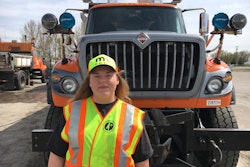April Coolidge was a real estate broker when the housing market crashed during the Great Recession. She decided to shift gears completely, follow in the footsteps of her father, and go to truck driving school.
The second-generation driver is now on her 11th year of driving with about 1.2 million safe driving miles under her belt, now working for Walmart Transportation and serving as a trucking industry ambassador as an American Trucking Associations (ATA) America’s Road Team Captain.
“I never would have thought that I would have gotten into this industry. My dad was a driver, but I didn't think that as a woman that would have been a path that I would have chosen. But it's been the most rewarding path, and I just absolutely am passionate and love what I do,” Coolidge said during a recent ATA webinar centered around its newest initiative. “It's been the best decision that I've ever made, and it gives me the flexibility to live my life and to earn a very good living for myself.”
That’s part of Coolidge’s story, and she uses it to advocate for women in trucking as a member of the ATA’s Women in Motion (WIM) speaker’s bureau.
WIM is ATA’s new initiative that launched in July to accelerate the rise of women throughout the industry – not just drivers – and help eliminate roadblocks that stand in their way. Working with coalition partners, policymakers and business leaders, WIM aims to create a more secure work environment for women truckers by advocating on issues like safer truck parking and greater diversity. The initiative offers career support and professional development opportunities for women in the industry in addition to promoting trucking careers to women across the country.
WIM’s speaker’s bureau, which includes women truck drivers, women trucking company executives and women state trucking association executives, educates and mentors women in the industry. Coolidge goes into high schools and speaks to young women about the truck driving profession.
“Not everybody is cut out for college, so one thing I really enjoy doing is when I go to these high schools and talk to these young people about the trucking industry, I let them know how much money I make, and the benefits, and retirement, everything,” she said. “They think twice about, ‘Maybe I want to go get into trucking.’ Had I had a woman come to my high school when I was younger, I might have gotten into this industry a lot sooner because I didn't have any women role models that showed me that this could be a possibility for myself.”
And Coolidge said she wants to inform young women about the many opportunities in trucking because there are so many misconceptions around what it means to be a woman truck driver, and it has enabled her to do things she otherwise would not have gotten to do.
ATA President and CEO Chris Spear said stories like Coolidge’s are pertinent to attracting women to the industry and advocating on behalf of the industry on Capitol Hill.
While WIM advocates for careers across the trucking industry, it focuses heavily on attracting women to the truck driver profession. Because of the massive national driver shortage, ATA, along with other organizations, is working to tap into a major portion of the population that has often been overlooked in the male-dominated industry.
“We've created an initiative that brings added spotlight on this critical talent pool of women in our industry, and it spans every occupation in trucking,” said ATA President and CEO Chris Spear. “It's a permanent addition to ATA, will be staffed permanently with full-time talent, and I'm very excited to be able to bring to bear the ATA’s ability to advocate issues that Women in Motion are identifying as critical to growing our workforce.”
One of those issues WIM is spotlighting is truck parking.
It has long been identified as a barrier to women entering the truck driving profession because of safety and security concerns. Along with other organizations, the ATA has been advocating for safer truck parking via the Truck Parking Safety Improvement Act, which if adopted will allocate $755 million over four years to projects that add truck parking capacity.
Rhonda Hartman, an America’s Road Team Captain and professional driver for Old Dominion Freight Line, said when she was an owner operator, she always tried to park where better lighting was available. While truck stops have been making improvements with truck parking at their facilities by offering things like additional lighting, parking reservations, security patrol and even shuttles from the lot to the building, Hartman, who now does pick-up and delivery and is home every night, said many of the rest areas could use more lighting.
But Coolidge said it shouldn’t stop women who are interested in the profession from becoming drivers; it comes down to planning, she said.
“I've stayed at truck stops and rest areas, and I've left at all hours of the night all throughout the night. Never have I felt that I was in a position that I felt threatened, but I plan my day accordingly,” Coolidge said. “We only have so many hours a day that we can drive so … a lot of times when I shut down the night before … I'll plan my day for the next day … because I know how far I'm going to be able to go, and I know the stops and things that I'm going to have to be making throughout the day. So that enables me to decide where I'm going to stay and make those choices that I feel is going to put me in a position where I feel that I'm the safest that I can be out here on the road.”
Hartman, who has been driving a semi for almost 40 years with over 3 million safe driving miles, said she remembers when she was responsible for the safety of, not only herself, but also her equipment when she was an owner operator, and having “state and private organizations work together would be an awesome idea that would tie those two things together and make people feel safer about parking.”
Spear said WIM’s goal is to work alongside other organizations with similar goals to make a greater impact, especially at the lawmaking level, by taking the time to listen to the professionals like Hartman and Coolidge.
“I firmly believe that if we listen to our women drivers, we get a better sense of what those barriers are. This is clearly a solution that ATA is at the forefront of driving, and I'm very proud of the fact that we've been able to match that ability to listen with our advocacy capability,” Spear said. “That's what makes Women in Motion so special is to take the issues that it identifies and bring to bear the ATA’s advocacy ability and … shaping those into strategies and hopefully outcomes. (Parking) is one of many examples that we’ll be focused on as this program begins to unveil.”
So far, WIM has launched its social media channels, participated in multiple career fairs, and has been working with its communications team to produce op-eds, said Elisabeth Barna, ATA’s executive vice president of industry affairs. Barna said there is a lot more work to do, and it will focus heavily on getting the women of its speaker’s bureau, including Coolidge and Hartman, out in the public to tell their stories.














